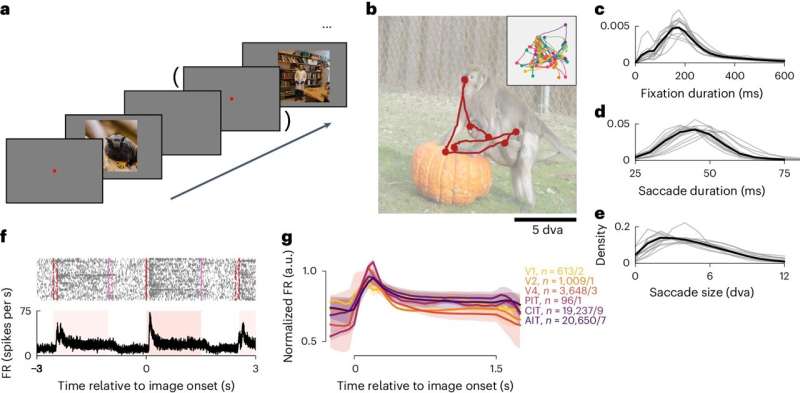This article has been reviewed according to Science X's editorial process and policies. Editors have highlighted the following attributes while ensuring the content's credibility:
fact-checked
peer-reviewed publication
trusted source
proofread
Macaque study sheds light on brain's perception of static images

We may not realize it, but our eyes constantly make rapid movements—two to three per second—even when we're looking at the same spot. Yet despite these frequent eye movements, we still perceive what we see as a stable whole.
How exactly do our eyes and brains work together to make this happen? Neurobiologists at Harvard Medical School (HMS) have now found intriguing clues into this question, which has captivated vision researchers far and wide.
The study, done in macaques and published April 29 in Nature Neuroscience, revealed that certain visual neurons in the brain simply see what's in front of the eyes, in real time—a departure from prior thinking that neurons use prediction of future images or analysis of past images to achieve stability. To make this finding, the team developed new methods for studying the visual system that are closer to what monkeys and humans see in daily life.
Although the results don't definitively explain how the brain forms stable images, they provide critical new clues about the visual system and open the door for more research.
Revising prevailing theories
For centuries, philosophers and scientists have asked how it's possible that we see the world as stable even though our eyes are constantly moving.
"There has been a long history of research on this topic, yet it's still largely unsolved," said lead author Will Xiao, research fellow in neurobiology in the Blavatnik Institute at HMS. "I thought this was a fascinating philosophical and perceptual question that we could study in the macaque visual system."
Xiao described two dominant ideas to explain this stability: Neurons in the brain might predict the next image based on where the brain is telling the eyes to move, or neurons might compare the new image to a previous one to detect changes. In both cases, neurons would use this additional information—future or past—to construct a stable image.
Compared to mice or rats, macaques have a visual system more similar to that of humans, and it takes up a large portion of their brains. As a result, macaques are the best study subjects for gaining insights about the visual system that are relevant to humans.
In the study, researchers analyzed neural activity in macaques during a visual task. During each session, a macaque sat in a chair and looked at a screen that showed a sequence of varied, real-world photos. The animal looked at each photo for an average of two seconds—about five to six eye fixations—and the session ended when the macaque decided to stop participating.
As a macaque looked at the photos, the researchers traced neural activity in a visual region called the ventral pathway. This region, which is divided into several smaller areas, processes detailed visual information such as shape or color to help the brain recognize and categorize objects.
"Our study is naturalistic; the macaques do not need to be trained—they naturally look around and explore interesting images, which allowed us to collect a very large set of data," Xiao explained.
In total, 13 macaques viewed thousands of photos, while researchers recorded 883 hours of neural activity.
Based on these recordings, the researchers found that neurons in the ventral pathway do not predict future images or remember past images. Instead, they simply perceive whatever image is directly in front of them in real time—something the researchers call "eye-centeredness."
"Basically, each neuron has tunnel vision—as if you were looking through a pinhole in a piece of paper—and when the eye moves, the neuron gets yanked to a new position, and only sees from the new position," Xiao said.
The work also represents an important advance in how vision research can be done. Previous studies focused on the presence or absence of simple images, such as basic shapes, textures, or isolated objects. By contrast, Xiao and colleagues presented the macaques with detailed photos of landscapes, animals, people, and other scenes. Because these photos are more realistic, the team could build and test theories about how neurons would respond to real-world surroundings with multiple objects.
The findings don't fully explain how neurons in the brain create a stable image of the world, but they pave the way for more naturalistic studies on the topic. The researchers plan to use their methods to study how neurons in other brain regions may integrate spatial and visual information—including regions that process motion and coordinate vision with actions. The team will also use these methods to study the visual system in macaques during normal daily behaviors.
Beyond understanding the basic biology of the visual system, the research could someday have implications for people who experience vision loss due to an accident or disease.
The retina, Xiao explained, is a highly complex organ that receives and transmits large amounts of information, much like a high-bandwidth device. Thus, there are major challenges that come with fully replacing the retina as a strategy for restoring vision. An alternative strategy is to replicate a higher-order visual region like the ventral pathway that has already processed and integrated much of the information gathered by the retina.
"High-order vision already deals with entire objects, so potentially you need to install fewer levers to restore visual perception—which might make this a more feasible approach," Xiao said.
More information: Will Xiao et al, Feature-selective responses in macaque visual cortex follow eye movements during natural vision, Nature Neuroscience (2024). DOI: 10.1038/s41593-024-01631-5



















